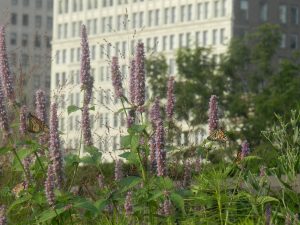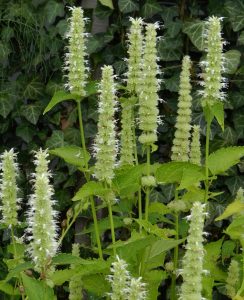
Agastache with Monarch butterflies
Last month, I spent most of a morning in the Lurie Garden at Millenium Park in Chicago and was flabbergasted by the number of Monarch butterflies on the Agastache ‘Blue Fortune’. I think it is just as attractive to pollinators as Asclepias.
I’ve been in love with Agastache for a long time. There are so many different ones. I want them all but have to be selective since my space is limited. The crucial piece of information that anyone planting them needs to know is that most of them require perfect drainage for them to survive our wet winters. That is why I add lots of Turface to any space in which I am planting Agastache.

Agastache ‘Golden Jubilee’ massed with more masses of Calamagrostis ‘Karl Foerster’ and Verbena bonariensis
The exception, in my experience, is A.foeniculum ‘Blue Fortune’ which seems perfectly happy in virtually any soil. Its cousin, ‘Golden Jubilee; performs similarly and adds another element of interest to the garden with its golden yellow or chartreuse foliage although the foliage color varies depending on the amount of sunlight it receives. Both grow approximately three feet tall and keep blooming throughout the summer and into the fall if deadheaded. I’ve recently become acquainted with a shorter cousin ‘Blue Boa’ that only grows two feet high and has fluffier spikes.

Agastache ‘Black Adder’ is interspersed with Echinacea, dahlias, Lythrum, and Veronicastrum in a stylized prairie in Europe where Lythrum is contained by a beetle.
Five years ago, Coen Jansen, a Dutch nurseryman, selected ‘Black Adder’, a cross of A. rugosa and A. foeniculum, for its black buds, slender spikes that are a blend of dark purple and pale purple, and dark green foliage.. In 2015, a shorter cousin named ‘Little Adder’ was introduced; it only grows fifteen to eighteen inches high. All of these are hardy to zone 5.

Agastache rugosa ‘Alabaster’
I’ve been growing Agastache rugosa ‘Alabaster’ since 1996. It seems to be satisfied with strong morning sun and afternoon shade and grows about four feet high; it might be shorter in full sun. It doesn’t bloom until late summer but the butterflies love it. It does seed a bit but not outrageously.

I planted Agastache rupestris at the entrance to a client’s home where it would receive no irrigation but thrived nevertheless.
Long before I became acquainted with the blue hyssops, I saw Agastache rupestris (Sunset Hyssop)on a a garden tour and was entranced by its delicate silver foliage and rosy-salmon tubular flowers. This hyssop loves it hot and dry but, again, drainage is crucial. It will grow three feet high and wide.
The Kudos Series has three colors so far: peachy pink, strong coral, and orange. They are supposedly hardy to zone 5 and I’m keeping my fingers crossed but don’t have experience with them yet although I have installed them in a few gardens. The flowers are tiny tubes but there are so many on a stalk that they will make an impact once they are mature. They are short, growing only fifteen inches high.
We can thank David Salman of High Country Gardens for introducing us to many of the hyssops that are well known in the Southwest. We in the Midwest discounted them for many years, assuming that they wouldn’t be hardy here but they are hardy to at least zone 6 and many are hardy to zone 5. I can’t emphasize enough that drainage is the key to survival. David’s catalog lists several other species and cultivars, many of which are pink, some short and some quite tall. These North American natives will make any environmentalist happy.
Agastache are showy, fragrant, and long blooming, through summer and early fall. Although supposedly adaptable to partial shade, I find that full sun is better. These perennials belong in a pollinator-friendly garden. They are attractive to hummingbirds, bees, and butterflies. Because of the anise and mint-scented foliage, deer and rabbits are not attracted to them. Where are you going to find space for them?


2 Comments